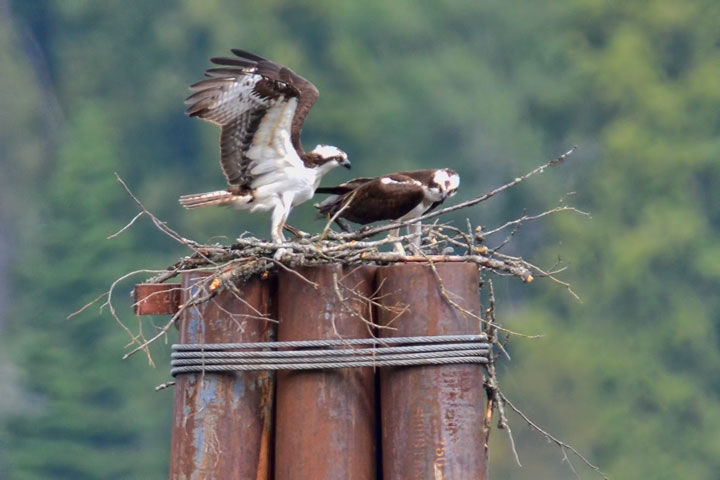It seems that 2011 is an annus horribilis for ospreys along the West Arm of Kootenay Lake. Normally there might be 20 or 30 nesting pairs on the stretch of water between Balfour and Nelson (there is variation: in 2009 there were 17). In late May this year, a survey by Janice Arndt and Elaine Moore found only three nests (two of which were inland). In early June, I searched a stretch of the Arm and found no osprey nests where there had been many in the past.
In early May, many ospreys had arrived at the Lake and started housekeeping just as they had done in other years. But by late May most nests were gone. What happened? We think we know, but would appreciate further insights.
High winds destroy nests
I had been monitoring a nest in front of my place and had made quite a few postings about it. I returned from a field trip on May 14 to find the nest gone and adjacent wind damage. Those birds have not returned. Janice Arndt monitored an osprey nest on a dolphin seen from her home. It was destroyed by high winds on May 13 and 14. Charlie Zinkan watched the nest at Sunshine Bay. Again, it was destroyed by high winds (but those ospreys seem to be trying to rebuild).
It seems likely that many nests along the West Arm were destroyed by high winds at the same time. A promising start had been blown away. Can anyone add any further evidence?
Ospreys at Sunshine Bay are trying to rebuild after high winds destroyed the first nest, but it seems that most other ospreys have just given up (picture taken June 13, 2011). 

What a shame! I haven’t been out to our property in Redfish yet. Anyone know if the pair on the beacon (just east of Harrop Ferry) are back? Seeing the Osprey is one of the hilights of being “At the Lake”. I love hearing their chirps (not sure if this is the right word – please correct if I’m wrong):
Female Osprey: What’s for dinner?
Male Osprey: Kokanee salmon …
Female Osprey: Fish again???
Anyway, love your posts – keep up the good work …
Ian, I didn’t look closely when I crossed on the Harrop ferry on Monday, but I sort of remember that nest being gone. Sigh…
I can hear ospreys in my area around 4 mile, but have no idea where their nest is.
Isa, there are some around. I occasionally see them in front of my place. But, crucially, most nests seem to have vanished. Likely, there will be few offspring this year.
I live in Crescent Valley, on the east side of the Slocan River. Have been watching an osprey nest on the west side of the river from my place. The osprey pair returned this spring and seemed to be settling in, the female sitting low on the nest by May 21st. Around June 10 I stopped seeing the female on the nest. Or the male in flying about. Their absence is a mystery. There has been no wind damage to this nest. It has been active for many years. Could the late high water affect the fishing and they have left for a better food source? I miss their presence, the sky feels empty without them.
Hi Patricia:
I think you are on the right track regarding the high water and the associated impacts on osprey breeding this season. As previously noted, the lack of osprey breeding success on the West Arm was partly attributed to one or more storms that have blown nests off their structures. However I think there is more to it than just a weather event or two. I published a paper documenting the impacts of weather on osprey foraging success, based on data gathered in Creston and Nelson BC. It was based on a summer of observing and following ospreys hunting in a boat and recording their hunting effort, energetic output, fish capture success, fish size and energetic value, as well as a bunch of weather parameters (windspeed, wind direction, water surface conditions, precipitation, temperature, etc.). The results of this work indicated that bad weather (rain, choppy water surface, winds) has detrimental effects on osprey hunting success and energetic costs of foraging. Two to three days of bad weather in a row can significantly impact an osprey pair/family because they catch way less fish and have to spend way more energy doing it. This in turn causes parents to spend more time away from the nest, more egg and nest predation, more brood reduction and siblicide amongst the chicks, and in summary more failed nests. High water levels coupled with the poor weather we have been having makes this even worse, because the traditional shallows where the ospreys feed are inundated and they have fewer shallow water productive hunting areas. from where to draw their fish from. I have been opportunisitically watching the ospreys hunting since they came back this spring, and there is sometimes many more dive attempta and time spent hunting per unit of fish caught along the shorelines in this poor weather with high water than in your “average” year. They simply are having to work harder because of the conditions this year, and eventually, some would be predicted to fail or abandon. That seems to be happening at more nests this year. Pity…